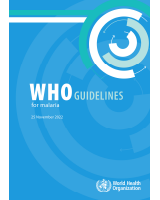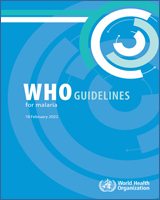- 4.1.1.
Interventions recommended for large-scale deployment
Strong recommendation for, High certainty evidence
Pyrethroid-only nets (2019)
WHO recommends pyrethroid-only long-lasting insecticidal nets (LLINs) that have been prequalified by WHO for deployment for the prevention and control of malaria in children and adults living in areas with ongoing malaria transmission.
Remark: WHO recommends ITNs that have been prequalified by WHO for use in protecting populations at risk of malaria, including in areas where malaria has been eliminated or transmission interrupted but the risk of reintroduction remains.
ITNs are most effective where the principal malaria vector(s) bite predominantly at night after people have retired under their nets. ITNs can be used both indoors and outdoors, wherever they can be suitably hung (though hanging nets in direct sunlight should be avoided, as sunlight can affect insecticidal activity).
Conditional recommendation, Moderate certainty evidence
Pyrethroid-PBO nets (2019)
WHO conditionally recommends pyrethroid-PBO nets prequalified by WHO for deployment instead of pyrethroid-only ITNs for the prevention and control of malaria in children and adults living in areas with ongoing malaria transmission where the principal malaria vector(s) exhibit pyrethroid resistance that is: a) confirmed, b) of intermediate level, and c) conferred (at least in part) by a monooxygenase-based resistance mechanism, as determined by standard procedures.
Good practice statement
Achieving and maintaining optimal coverage with ITNs for malaria prevention and control (2019)
To achieve and maintain optimal ITN coverage, WHO recommends that countries apply mass free net distribution through campaigns, combined with other locally appropriate delivery mechanisms such as continuous distribution using antenatal care (ANC) clinics and the Expanded Programme on Immunization (EPI).
Recipients of ITNs should be advised (through appropriate communication strategies) to continue using their nets beyond the three-year expected lifespan of the net, irrespective of the condition and age of the net, until a replacement net is available.
Good practice statement
Management of old ITNs (2019)
WHO recommends that old ITNs should only be collected where there is assurance that: i) communities are not left without nets, i.e., new ITNs are distributed to replace old ones; and ii) there is a suitable and sustainable plan in place for safe disposal of the collected material.
If ITNs and their packaging (bags and baling materials) are collected, the best option for disposal is high-temperature incineration. They should not be burned in the open air. In the absence of appropriate facilities, they should be buried away from water sources and preferably in non-permeable soil.
WHO recommends that recipients of ITNs be advised (through appropriate communication strategies) not to dispose of their nets in any water body, as the residual insecticide on the net can be toxic to aquatic organisms (especially fish).
Strong recommendation for, Low certainty evidence
Indoor residual spraying (2019)
WHO recommends IRS using a product prequalified by WHO for the prevention and control of malaria in children and adults living in areas with ongoing malaria transmission
Remark:
DDT, which has not been prequalified, may be used for IRS if no equally effective and efficient alternative is available, and if it is used in line with the Stockholm Convention on Persistent Organic Pollutants.
IRS is considered an appropriate intervention where:
the majority of the vector population feeds and rests indoors;
the vectors are susceptible to the insecticide that is being deployed;
people mainly sleep indoors at night;
the malaria transmission pattern is such that the population can be protected by one or two rounds of IRS per year;
the majority of structures are suitable for spraying; and
structures are not scattered over a wide area, resulting in high transportation and other logistical costs.
Good practice statement
Access to ITNs or IRS at optimal coverage levels (2019)
WHO recommends ensuring access to effective vector control using ITNs or IRS at optimal coverage levels for all populations at risk of malaria in most epidemiological and ecological settings.
- 4.1.2.
Combining ITNs and IRS
Conditional recommendation against, Moderate certainty evidence
Prioritize optimal coverage with either ITNs or IRS over combination (2019)
WHO recommends against combining ITNs and IRS and that priority be given to delivering either ITNs or IRS at optimal coverage and to a high standard, rather than introducing the second intervention as a means to compensate for deficiencies in the implementation of the first intervention.
Remark:
In settings where optimal ITN coverage, as specified in the strategic plan, has been achieved and where ITNs remain effective, additionally implementing IRS may have limited utility in reducing malaria morbidity and mortality. Given the resource constraints across malaria-endemic countries, it is recommended that effort be focused on good-quality implementation of either ITNs or IRS, rather than deploying both in the same area. However, the combination of these interventions may be considered for resistance prevention, mitigation or management should sufficient resources be available.
Good practice statement
No scale-back in areas with ongoing local malaria transmission (2019)
In areas with ongoing local malaria transmission (irrespective of both the pre-intervention and current level of transmission), WHO recommends that vector control interventions should not be scaled back. Ensuring access to effective malaria vector control at optimal levels for all inhabitants of such areas should be pursued and maintained.
- 4.1.3.
Supplementary interventions
Conditional recommendation, Low certainty evidence
Larviciding (2019)
WHO conditionally recommends the regular application of biological or chemical insecticides to water bodies (larviciding) for the prevention and control of malaria in children and adults living in areas with ongoing malaria transmission as a supplementary intervention in areas where optimal coverage with ITNs or IRS has been achieved, where aquatic habitats are few, fixed and findable, and where its application is both feasible and cost-effective.
Remark:
Since larviciding only reduces vector density, it does not have the same potential for health impact as ITNs and IRS – both of which reduce vector longevity and provide protection from biting vectors. As a result, larviciding should never be seen as a substitute for ITNs or IRS in areas with significant malaria risk but represents a potential supplementary strategy for malaria control. Larviciding will generally be most effective in areas where larval habitats are few, fixed and findable, and likely less feasible in areas where the aquatic habitats are abundant, scattered and variable.
The following settings are potentially the most suitable for larviciding as a supplementary measure implemented alongside ITNs or IRS:
urban areas: where breeding sites are relatively few, fixed and findable in relation to houses (which are targeted for ITNs or IRS);
arid regions: where larval habitats may be few and fixed throughout much of the year.
Larval habitat modification and/or larval habitat manipulation (2021)
No recommendation can be made because the evidence on the effectiveness of a specific larval habitat modification and/or larval habitat manipulation intervention for the prevention and control of malaria was deemed to be insufficient.
Larvivorous fish (2019)
No recommendation can be made because no evidence on the effectiveness of larvivorous fish for the prevention and control of malaria was identified.
Conditional recommendation against, Low certainty evidence
Topical repellents (2019)
WHO conditionally recommends against the deployment of topical repellents for the prevention and control of malaria at the community level in areas with ongoing malaria transmission.
Remark:
Further work is required to investigate the potential public health value of topical repellents to separate out potential effects at the individual and/or community level. Analysis conducted to date indicates that no significant impact on malaria can be achieved when the intervention is deployed at community-level due to the high level of individual compliance needed.
Conditional recommendation against, Low certainty evidence
Insecticide-treated clothing (2019)
WHO conditionally recommends against deployment of insecticide-treated clothing for the prevention and control of malaria at the community level in areas with ongoing malaria transmission; however, insecticide-treated clothing may be beneficial as an intervention to provide personal protection against malaria in specific population groups.
Remark: In the absence of insecticide-treated nets, there is some evidence that insecticide-treated clothing may reduce the risk of malaria infection in specific populations such as refugees and military; it is presently unclear if the results are applicable to the general population.
Spatial/Airborne repellents (2019)
No recommendation can be made because the evidence on the effectiveness of spatial/airborne repellents for the prevention and control of malaria was deemed to be insufficient.
Conditional recommendation against, Very low certainty evidence
Space spraying (2019)
WHO conditionally recommends against using space spraying for the prevention and control of malaria in children and adults living in areas with ongoing malaria transmission; IRS or ITNs should be prioritized instead.
Conditional recommendation, Low certainty evidence 
House screening (2021)
WHO conditionally recommends the use of untreated screening of residential houses for the prevention and control of malaria in children and adults living in areas with ongoing malaria transmission.
Remark:
This recommendation addresses the use of untreated screening of windows, ceilings, doors and/or eave spaces, and does not cover other ways of blocking entry points in houses.
- 4.1.4.
Other considerations for vector control
- 4.1.4.1.
Special situations
- 4.1.4.2.
Implementation challenges
- 4.1.4.3.
Monitoring and evaluation of vector control
- 4.1.5.
Research needs



